#with thymic carcinomas
Text
sitting here scanning through research papers about thymomas trying to figure out if Wilson could have had cancer the entire series because i’ve got problems
the answer is yes by the way
#cancer //#medical //#house md#james wilson#so thymomas are slow growing and have been recorded as taking up to TEN YEARS for a tumour to double in size#the problem is#there isnt' a lot of research done on this particular topic#and the studies i can find have relatively low data pools#which makes sense because it's a pretty specific cancer#but that means that pretty well all studies into the doubling time (VDT) of thymomas ALSO include patients#with thymic carcinomas#and thymic cysts#both of which are fast growing#and most papers distinguish between them but some just straight up loop them all together#which is just stupid#so these things combined means what studies i have looked at all have a wide range of VDTs assigned to thymoma specifically#but based on the size of wilson's tumour#it's entirely possible he's had it the entire time we've known him#in fact#i'd call it likely#i am#not a doctor#don't quote me on this
167 notes
·
View notes
Text
Okay gonna make a public post about this so that I can vent about it without being extremely vague.
I have thymus cancer. Most likely thymoma, but possibly thymic carcinoma, they won’t know for sure until they can biopsy it. Getting surgery to remove it next month. Prognosis is really good, I got very lucky to have caught it early on a CT scan for something unrelated. So that’s happening. Expect occasional vent posts and block the tag #healthblogging if you’d (very understandably) rather not have that on your dash. Fingers crossed surgery goes smoothly and I can close the door on this chapter of my life as soon as possible.
15 notes
·
View notes
Text
Hey everyone! My best friend, DrekkDeina, and his wife need help. His wife, Allie, is battling cancer and anything will help—even just sharing the link. Thank you 💜
6 notes
·
View notes
Text
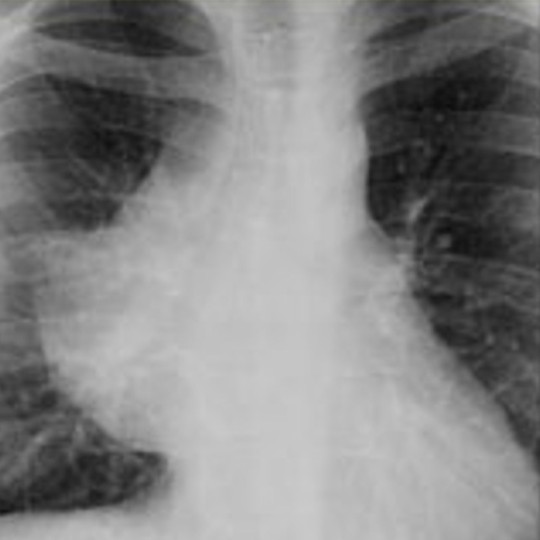
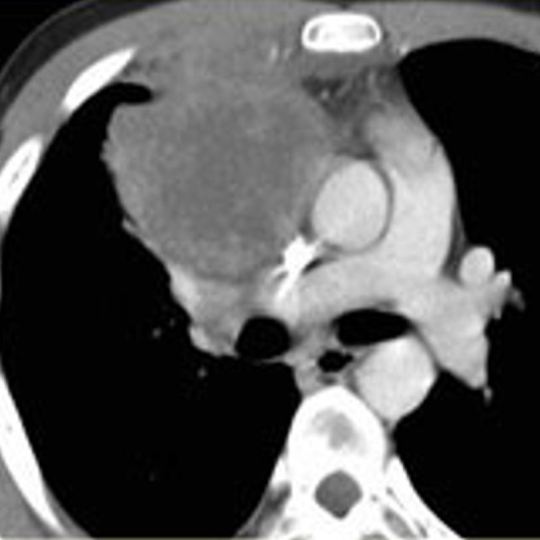
Here is another mass overlying the right hilum on chest radiograph. Obtuse angles with the lung localize this to the mediastinum. You can see the hilar vessels through the mass, so it is not in the middle mediastinum (this is known as the hilum overlay sign - if it were in the middle mediastinum it would obscure the vessels). The majority of the right heart border is obscured by the mass so this must be in the anterior mediastinum (this is the silhouette sign - loss of a border due to an adjacent finding). The anterior location is confirmed at CT.
So what is the differential diagnosis for an anterior mediastinal mass? A popular mnemonic is the 4 T's - thymoma (or other thymic mass), teratoma (or other germ cell tumor), thyroid carcinoma (or goiter), and (terrible) lymphoma. Vascular lesions are also possible, but these tend to arise from the middle mediastinum.
At biopsy, this mass proved to be a lymphoma.
Source: S. Balla. Masses Differential Diagnosis. RadiologyAssistant.nl
#TeachingRounds#FOAMEd#FOAMRad#Anatomy#mediastinum#radiology#chestrad#chestradiology#cardiothoracicradiology#xray#chestxray
0 notes
Text
What distinguishes the expertise and techniques of the best robotic cancer surgeon in India when it comes to effectively addressing thymus cancer, including thymoma and thymic carcinoma?
Seeking treatment for thymus cancer? Look no further than the expertise of the best robotic cancer surgeon in India. Thymoma or thymic carcinoma, rare malignancies rooted in the thymus gland, call for specialized surgical intervention.
#roboticcancersurgeoninpanipat#roboticcancersurgeoninhisar#roboticcancerdoctorinkanpur#roboticcancerdoctorinmuzaffarnagar#roboticcancerdoctorinrohtak#roboticcancersurgeoningurgaon#bestroboticcancersurgeoninindia
0 notes
Text
Thymic Carcinoma Market is Expected to Expand at a Healthy Growth Rate During the Forecast Period (2023-2032)| Key Companies – Roche Pharmaceuticals, Tiziana Life Science
http://dlvr.it/SsKykc
0 notes
Text
Thymus Cancer Market: Current State and Future Prospects
Introduction: Thymus cancer, also known as thymoma or thymic carcinoma, is a rare type of cancer that affects the thymus gland, a small organ located in the chest. The global market for thymus cancer treatment is relatively small compared to other types of cancer, due to the rarity of the disease. However, recent advancements in medical research and the increasing prevalence of thymus cancer are driving the growth of the market.
Current State: The thymus cancer market is currently driven by chemotherapy and radiation therapy, which are the most common treatment options. However, surgery is often the preferred method of treatment for localized thymus cancer, as it can lead to better outcomes and higher survival rates.
The market is also witnessing the development of targeted therapies and immunotherapy, which are emerging as promising treatment options for thymus cancer. Targeted therapies work by targeting specific molecules in cancer cells, while immunotherapy works by stimulating the immune system to attack cancer cells.
Future Prospects: The thymus cancer market is expected to grow in the coming years, driven by increasing awareness and diagnosis of the disease. Additionally, the development of new treatment options, such as targeted therapies and immunotherapy, will further drive market growth.
One of the major challenges facing the thymus cancer market is the lack of standardization in diagnosis and treatment protocols. This has led to variability in patient outcomes and a lack of consensus on the best treatment options. However, efforts are being made to standardize protocols and develop guidelines for diagnosis and treatment.
Another challenge is the high cost of treatment, which can limit patient access to new therapies. However, the increasing availability of generic drugs and the development of biosimilars are expected to mitigate this challenge in the coming years.
Conclusion: The thymus cancer market is a small but growing industry, driven by advancements in medical research and increasing awareness and diagnosis of the disease. The market is expected to continue its growth trajectory in the coming years, driven by the development of new treatment options and standardization of diagnosis and treatment protocols. However, challenges such as the lack of standardization and high treatment costs must be addressed to ensure that patients have access to the best possible care.
0 notes
Text
0 notes
Link
0 notes
Link
The open-label study (NCT04489420) had its status changed to “terminated” in a ClinicalTrials.gov update on 27 January, and the PTSR change occurred the next day. According to the trial registry, the study was terminated based on a business decision.
The study originally sought to find the asset’s maximum safe dose (MSD) or the maximum tolerated dose (MTD) in 36 subjects with GBM but enrolled only 3 individuals. CYNK-001 is an intravenous allogeneic natural killer-cell therapy designed to target tumour cells.
0 notes
Text
Thoracic Cancer & It's Symptoms - Dr. Lalit Banswal : Best Thoracic Cancer Doctor in Undri,Pune
Dr. Lalit Banswal is the Best Thoracic Cancer Doctor in Undri,Pune. Visit & Consult Now to Know More About The Treatment.
Thoracic cancer refers to any cancer located in the organs, glands, or structures of your thoracic cavity, or chest. This includes well-known cancers such as lung cancer (currently the second-most common cancer among both men and women) and esophageal cancer, as well as less common cancers such as thymus cancer and pleural cancer. Dr. Lalit Banswal is here to support you through your journey with thoracic cancer. Find a Doctor today to set up a personalized treatment plan.
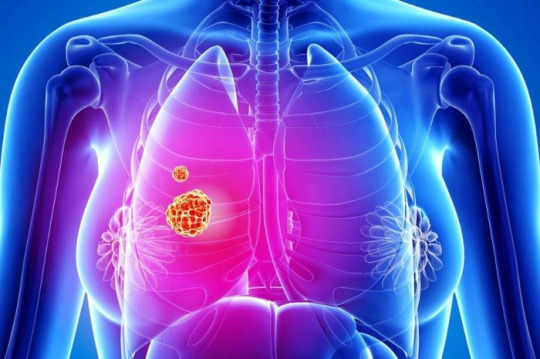
Symptoms:
Thoracic cancer symptoms vary based on the specific cancer type and the tissue it affects. In the early stages, there are often no symptoms, and as a result, thoracic cancer is harder to diagnose until it is at an advanced stage.
A new cough that does not go away or gets worse with time
Changes in a chronic cough or “smoker’s cough”
Chest pain that worsens with laughing, deep breathing, or coughing
Coughing up blood or bloody or rust-colored mucus
Fatigue
Heartburn, indigestion, or vomiting
Hoarseness
Shortness of breath or wheezing
Unintentional weight loss or unexplained loss of appetite
Weakness
These symptoms are also common in other conditions, which means that noticing one or more doesn’t mean you have cancer. Some people are also diagnosed without noticing any signs at all. Seeing a doctor is the only way to know for sure.
Causes:
Cancer occurs after accumulated damage to cellular DNA. When genes are damaged, they may mutate. These mutations then cause abnormal cell growth that can spread through the body. Thoracic cancers occur when this abnormal growth happens in the chest cavity. Health experts don’t fully understand the cause of any cancer, including thoracic cancer. Biological factors such as genes (some cancers tend to run in families), age, and hormones can contribute to cell damage and increase cancer risk. Other risk factors are environmental, such as exposure to sunlight radiation or carcinogenic (cancer-causing) substances including asbestos and radioactive materials. For thoracic cancers, lifestyle factors like diet, body weight, and smoking especially play a role. In fact, smoking is linked to 90 percent of lung cancer cases, and also substantially increases the risk of esophageal cancer.
Types:
Thoracic cancer includes all cancers occurring in the chest cavity, including lung cancers, thymic cancers, and tracheal (windpipe) cancers. Lung cancers are by far the most common type of thoracic cancer.
Some of the most common chest cavity cancers are:
Non-small cell lung cancer: About 85 percent of lung cancers are non-small cell lung cancers (NSCLCs). These cancers include adenocarcinoma (a type of cancer beginning in the mucus-secreting cells in the lungs), squamous cell carcinoma (a type of cancer starting in the lung’s lining cells), and large cell carcinoma (which can begin in any part of the lung).
Small-cell lung cancer: 10–15 percent of lung cancers are small-cell cancers. This kind of cancer can start anywhere in the lung and typically grows quickly, making it easier to treat but also more likely to return over time.
Mesothelioma: Mesotheliomas begin in the pleura, peritoneum, or other “lining” tissues in the abdominal cavity. Thymoma (also called thymic malignancy): The thymus is a small organ in the chest that sits just under the breastbone and regulates the lymph system (which makes white blood cells). Cancers that occur in the thymus are called thymomas or thymic malignancies.
Other cancers: Breast cancer, pancreatic cancer, and some other cancers originating elsewhere in the body can sometimes metastasize to the lungs or other organs in the chest cavity, causing thoracic cancer.
Risk Factors:
The most significant risk factor for thoracic cancer is smoking. Almost all lung cancers occur in people who previously or currently smoke. Small-cell lung cancer, in particular, rarely occurs in people who haven’t smoked. The more time you spend smoking, and the more cigarettes you smoke, the higher your risk. Being around other people who smoke also increases your risk. This “second-hand” smoke causes thousands of cases of thoracic cancer every year.
Other common risk factors include:
Exposure to radiation and radioactive materials: previous treatment for other cancers, exposure to radon, and excessive UV radiation all increase the likelihood of thoracic cancer
Workplace exposures: working with asbestos (common in mines, some factories, and shipyards, for example) increases the possibility of lung cancer
Exposure to other carcinogens: heavy metals like arsenic, beryllium, and cadmium are also carcinogenic, as are silica, coal, air pollution, and diesel fumes
Family history of lung cancer
Prevention
Many of the exposures and factors that increase risk of thoracic cancer — such as family history, radiation, and air pollution — can’t be avoided completely.
There are still steps you can take to lower your risk, such as:
Not smoking. Avoiding cigarettes and tobacco products of all kinds is the best way, by far, to reduce the risk of thoracic cancers. If you currently smoke, the faster you quit, the better.
Using proper protective equipment. Using a mask or another approved protective device to avoid inhaling coal dust, silica, or other known carcinogens can reduce your risk.
Reducing your exposure to toxic substances wherever possible.
Maintaining your overall health through diet and regular exercise.
Attending regular physical exams.
#Thoracic Cancer Specialist in Undri Pune#Expert Lung Cancer Specialist in Undri Pune#Best Lung Cancer Hospital in Undri Pune#Best Thoracic Cancer Doctor in Undri Pune#Best Lung Cancer Doctor in Pune#Thoracic Cancer Hospital in Pune
0 notes
Text
Repair Surgery with regard to Unresectable Sophisticated Esophagogastric Junction Carcinoma together with Numerous Liver organ Metastases right after Successful Second-Line Remedy using Nab-Paclitaxel along with Sorafenib Following a Refractory A reaction to S-1 as well as CDDP Therapy-A Circumstance Record
9%): 25 thymomas, Being unfaithful thymic carcinomas, and also Being unfaithful thymic carcinoids. There have been 27 adult men along with 21 women which has a mean age of Fifty-one a long time (variety, 28 to be able to Eighty three). Retrospective graph review was done. Pertinent aspects for recurrence as well as emergency and progression-free interval were analyzed. Results. The typical follow-up period through the first functioning #Link# ended up being 83 several weeks (assortment, In search of to be able to 515). Repeat badly influenced total success throughout surgically resected thymic cancers (s Is equal to Zero.0014). In multivariate analysis, your initial Masaoka stage, imperfect resection, and also Globe Health Organization histology have been significant risks with regard to repeat. In multivariate examination, only surgical operations ended up being related to prolonged emergency g Equals 3.0038) along with increased progression-free period of time (s Equates to 0.0378) inside recurrent thymoma. Five-year success soon after repeated thymoma has been 54%. With regard to persistent thymic carcinoma, surgery failed to increase survival. Because of these individuals, radiation treatment had been associated with improved progression-free time period following recurrence (p Equals 0.0295). There are simply no 5-year heirs regarding recurrent thymic carcinoma. Conclusions. The information suggest that medical administration is owned by better result and is the treating option for frequent thymoma. With regard to persistent thymic carcinoma, operative operations includes a very limited role, and radiation is apparently a much more powerful therapy method.Methylations regarding ethene, propene, along with butene by simply methanol within the citrus microporous H-ZSM-5 prompt are generally researched by using state of the art computational tactics, for you to obtain #Link# Arrhenius burial plots as well as charge constants through first rules that can directly end up being in comparison with the experimental files. For these important elementary reactions in the methanol in order to hydrocarbons (MTH) process, direct kinetic data grew to become obtainable just recently [J. Catal. 2006, 224, 115-123; J. Catal. August 2005, 234, 385-400]. From Three hundred and fifty diplomas D, evident service energies involving 103, 69, along with Forty-five kJ/mol and also fee always the same of two.Six times 12(-4), 4.Your five x 12(-3), and One particular.Thrice 15(-2) mol/(gary h mbar) regarding ethene, propene, along with butene were ;derived, providing right after relative ratios regarding methylation nited kingdom(ethene)/k(propene)/k(butene) Equates to 1:17:50. In this work, fee constants such as pre-exponential factors tend to be determined that provide excellent arrangement together with the trial and error data: obvious service energies associated with 94, 58, and Thirty seven kJ/mol regarding ethene, propene, as well as butene are simply, as well as family member proportions regarding methylation nited kingdom(ethene)/k(propene)/k(butene) = One:Twenty three:763. The actual entropies involving gas phase alkenes are underestimated from the harmonic oscillator approximation as a result of event of internal rotations. These lower vibrational methods ended up replaced by personally created partition characteristics. All round, absolutely the impulse prices might be #Link# worked out with close to substance accuracy and reliability, and also qualitative styles are very reproduced.
0 notes
Text
ok so it’s really fucking dumb when you know about cancer so you kNoW that since wilson had a stage ii thymoma he had waaaay more than 5 months to live like wtf that’s so annoying
#shitpost#kinda#house md#dr wilson#james wilson#like it wasn't thymic carcinoma#it was a thymoma#people with stage 3 and 4 have a 40% 10 year survival rate#stage 3 and 4#like#buddy#you had way longer than 5 months are you sure you're an oncologist#unless it was thymic carcinoma and they just didn't wanna confuse everyone#in that case yeah no he's fucked#but i'm like 90% sure it was thymoma????
3 notes
·
View notes
Text
Thymus
The thymus is a specialised primary lymphoid organ of the immune system.
At its largest and most active during the neonatal and pre-adolescent periods.
Decreases in size and activity through teenage years
Thymus tissue is gradually replaced by adipose tissue (fat).
Residual T lymphopoiesis continues throughout adult life.
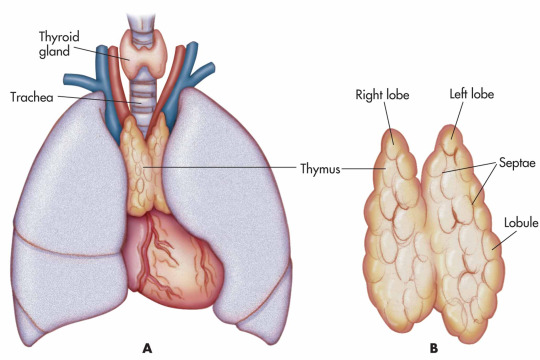
The thymus is composed of two identical lobes and is located in the anterior superior mediastinum, in front of the heart and behind the sternum. Each lobe of the thymus can be divided into a central medulla and a peripheral cortex which is surrounded by an outer capsule.
Function
Facilitates the maturation of T cells - which provide cell-mediated immunity.
T cells begin as hematopoietic precursors from the bone-marrow, and migrate to the thymus, where they are referred to as thymocytes.
In the thymus they undergo a process to ensure the cells react against antigens ("positive selection"), but that they do not react against antigens found on body tissue ("negative selection").
Once mature, T cells emigrate from the thymus to provide vital functions in the immune system.
Each T cell has a distinct T cell receptor, suited to a specific substance, called an antigen.
Most T cell receptors bind to the major histocompatibility complex on cells of the body.
Positive selection
T cells have distinct T cell receptors. These are formed by process recombination gene rearrangement which is error-prone, and some thymocytes fail to make functional T-cell receptors, whereas other thymocytes make T-cell receptors that are autoreactive. The survival and nature of the T cell then depends on its interaction with surrounding thymic epithelial cells.
T cell receptor interacts with the MHC molecules on the surface of epithelial cells.
A T cell with a receptor that doesn't react, or reacts weakly will die by apoptosis.
A T cell that does react will survive and proliferate.
A mature T cell expresses only CD4 or CD8, but not both.
Negative selection
T cells that attack the body's own proteins are eliminated in the thymus. Epithelial cells in the medulla and dendritic cells in the thymus express major proteins from elsewhere in the body. Some CD4 positive T cells exposed to self antigens persist as T regulatory cells.
Pathology
Immunodeficiency - As the thymus is the organ of T-cell development, any congenital defect in thymic genesis or a defect in thymocyte development can lead to a profound T cell deficiency in primary immunodeficiency disease.
Autoimmune disease - Genetic disorders, such as Myasthenia gravis: caused by antibodies that block acetylcholine receptors.
Thymomas - Originate in thymic epithelial cells most often in adults older than 40. Generally detected when they cause symptoms, such as a neck mass or affecting nearby structures such as the superior vena cava. Can be benign; benign but by virtue of expansion, invading beyond the capsule of the thymus ("invasive thyoma"), or malignant (a carcinoma).
Lymphomas - Tumours originating from T cells of the thymus form a subset of acute lymphoblastic leukaemia (ALL)
Thymic cysts - The thymus may contain cysts, usually less than 4 cm in diameter. Thymic cysts are usually detected incidentally and do not generally cause symptoms.
#thymus#thymoma#lymphatic#lymphatic system#immunology#immune system#t cells#medicine#biomed#biomedicine#notes#medblr#studyblr#sciblr#premed#nursing#biology#human biology#med#biomedical science#science#2#anatomy
196 notes
·
View notes
Link
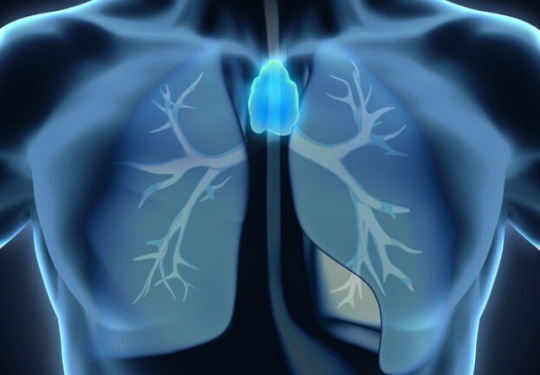
Thymoma and thymic carcinomas are a kind of malignancy that influences the thymus, an organ situated in the middle of the breastbone and the heart. Thymus is an organ that capacities to develop the T-cells which are the troopers of the insusceptible framework and are vital to the body's capacity to adjust to and fend off new diseases from different microbes like microorganisms, infections and parasites. Thymoma Treatment in Delhi | Best Thymoma Treatment in Delhi | Dr. Belal Bin Asaf
#Thymoma Treatment in Delhi#Best Thymoma Treatment in Delhi#Lung Cancer Specialist in Delhi#Best Lungs Doctor in Delhi
1 note
·
View note